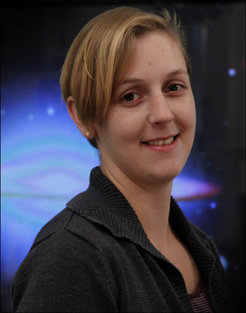Alumni 2015
Fabo Feng (21.1.) - Julian Stuermer (29.1.) - László Szűcs (30.1.) - Elena Manjavacas (3.2.) - Mei Sasaki (4.2.) - Siddharth Hegde (4.2.) - Nikolay M. Kacharov (4.2.) - Robert A. Singh (4.2.) - Siyi Feng (6.2.) - Salvatore Cielo (15.2.) - Alberto Nardin (17.14.) - Ruoyu Liu (10.6.) - Sven Meyer (15.6.) - Eduaro Banados (30.6.) - Camilla Penzo (7.7.) - Michael Maseda (8.7.) - Maria Kapala (10.7.) - Anahi Caldu Primo (10.7.) - Alex Buedenbender (16.7.) - Britta Zieser (17.7.) - Fabrizio Arrigoni Battaia (22.7.) - Christian Baczynski (23.7.) - Frederik Schönebeck (23.7.) - Akin Yildirim (30.7.) - Anders Thygesen (14.10.) - Andreas Bauer (14.10.) - Aiara Lobo Gomes (29.10.) - Terese Hansen (4.11.) - Benjamin Henricks (18.11.) - Simona Ciceri (7.12.) - Jan Rybizki (8.12.) - Dennis Kuegler (9.12.) - Christine Koepferl (9.12.) - Eleonora Sarli-Waizmann (18.12.) - Agnese Fabris (18.12.)
Agnese Fabris ( Italy ) - 18.12.2015
Light and shadow on gravitational flexion measurements (thesis pdf, 8 MB)
Is gravitational flexion reliably measurable in realistic observational conditions? To address this question we undertook an exhaustive investigation into the problem of estimating flexion. By means of synthetic data, we tested the ability of different methods to recover the shape of faint background galaxies with the level of detail necessary to account for the spin-1 and spin-3 distortions caused by flexion. Three different methods for weak lensing measurements have been extended in order to measure the high-order moments of surface brightness necessary to quantify the flexion-induced deformations. We observed that, for the two methods which exploit a weight function to control the noise and afterwards correct for the impact of this procedure, a successful outcome depends upon numerous assumptions on the properties of the objects investigated, making these techniques less appealing for practical applications. The third method we tested employs a principal component analysis algorithm to de-noise the images. Even though, in the most strict observational conditions, we could not achieve a precise measurement of the high-order distortions, this method stood out as a promising technique for shape measurements in weak lensing applications. Our analysis shows that a deeper understanding of the impact of pixel noise on the flexion estimators is required before measurements of flexion in real data can be carried out and, finally, used to exploit the vast potential of gravitational flexion.
Supervisor: Matthias Bartelmann (ITA)
Eleonora Sarli-Waizmann ( Italy ) - 18.12.2015
An algorithm for the reconstruction of the projected gravitational potential of galaxy clusters from galaxy kinematics (thesis pdf, 7 MB)
In this work we develop a method to incorporate the information from galaxy kinematics into the reconstruction of the two-dimensional, projected gravitational potential of galaxy clusters.
We start by deprojecting the observed line-of-sight velocity dispersions of cluster galaxies with an application of Bayes' theorem, the Richardson-Lucy method, requiring the assumption of a shape for the cluster. Assuming spherical symmetry, after the deprojection we obtain an effective galaxy pressure, i.e. the density-weighted radial velocity dispersions of the cluster galaxies, which is then related to the three-dimensional gravitational potential by using the tested assumption of a polytropic relation between the effective galaxy pressure and the density. The two-dimensional gravitational potential can finally be found by straightforward projection along the line of sight. We test the method with a numerically simulated triaxial galaxy cluster and the galaxies identified therein and perform the reconstruction for three different lines of sight, initially assuming sphericity. Expanding the gravitational potential in the cluster's geometrical ellipticities yields second-order corrections to the spherical reconstruction. By comparing our results with the projected gravitational potential directly obtained from the simulation, we show that the deviation between the projected potential obtained with our reconstruction method and the potential directly extracted from the simulation is $\lesssim10~\%$ within approximately the virial radius ($1.5\,h^{-1}\mathrm{Mpc}$) from the cluster centre in the case of a spherical cluster and remains moderate (below $10\,\%-25\,\%$) within the same radius in the case of an ellipsoidal cluster.
Supervisor: Matthias Bartelmann (ITA)
Jan Rybizki ( Germany ) - 08.12.2015

Inference from modelling the chemodynamical evolution of the Milky Way disc (thesis pdf, 15 MB)
In this thesis, the field star Initial Mass Function (IMF) and chemical evolution parameters for the Milky Way (MW) are derived using a forward modelling technique in combination with Bayesian statistics. Starting from a local MM disc model, observations of stellar samples in the Solar Neighbourhood are synthesised and compared to the corresponding volume-complete observational samples of Hipparcos stars. The resulting IMF, derived from observations in the range from 0.5 to 8Msun, is a two-slope broken power law with powers of -1.49 +- 0.08 and -3.02 +- 0.06 for the low-mass slope and the high-mass slope, respectively, with a break at 1.39 +- 0.05 Msun. In order to constrain the IMF for stars more massive than 8Msun, a fast and flexible chemical enrichment code, Chempy, was developed, which is also able to reproduce spatial and stellar population selections of observational samples. The inferred high-mass slope for stellar masses above 6Msun is -2.28 +- 0.09, accounting for the systematic effects of different yield sets from the literature. This shows that constraints from chemical modelling, similarly to hydrodynamical simulations of the Galaxy, demand a Salpeter high-mass index. This is hard to recover from star count analysis given the rareness of high-mass stars.
Supervisor: Andreas Just (ARI)
Christine Koepferl ( Germany ) 09.12.2015
Global Star Formation Properties Extracted from Synthetic Star-forming Regions:
Measurements, Analysis, and Calibration (thesis papers see this link)
In the field of star formation, there are still open questions regarding the transition from gas to stars. When addressing these questions, we need to ensure that the star formation properties, such as the gas mass, the stellar mass, and the star formation rate (SFR) are measured accurately. In this compilation, we test the accuracy of commonly used measurement techniques to infer star formation properties through radiative transfer modeling. We present a tool called the FluxCompensator, which can produce realistic synthetic observations by modeling all the effects introduced by a telescope and a detector. We show that in the Central Molecular Zone (CMZ), the main-sequence stars can be misclassified as Young Stellar Objects (YSO), contaminating the SFR estimated directly from young stars by at least 60%. We describe, in detail, how to produce reliable, realistic synthetic observations of synthetic star-forming regions that originate from particle-based hydrodynamical simulations, and we present ≈5800 realistic synthetic multi-wavelength observations at different evolutionary stages, distances, and orientations. The recovered properties extracted from the commonly applied modified black body fitting technique such as gas mass, dust density, and dust temperature show large errors, especially in the presence of star formation. We show that globally calibrated indirect diffuse star formation tracers, which are used to infer the SFR from infrared emission, do not work for single star-forming regions, but rather there is a relation between the infrared emission and the stellar mass. We find that the counted YSOs follow the instantaneous SFR much better than the diffuse tracers.
Supervisor: Thomas Robitaille (MPIA)
Dennis Kuegler ( Germany ) 09.12.2015

On the application of machine learning approaches in astronomy:
Exploring novel representations of high-dimensional and complex astronomical data (thesis pdf, 45 MB)
The goal of the presented work is the application of data-driven methods on complex and high- dimensional astronomical databases. The focus of the work is the exploration of novel data representations in order to enable the use of statistical learning approaches in the analysis of data. With the help of diverse science cases, the advantages of the introduced approaches for classication, visualization and regression tasks are shown by applying the developed methodology to astronomical data. In the first part, an alternative approach for estimating redshifts of spectra by using the knowledge about the redshifts provided by the SDSS pipeline is presented. A novel data repre- sentation is employed which contains only information relevant for estimating the redshift and the detection of multiple redshift systems. Subsequently, a novel data representation for regu- larly sampled light curves based on recurrent networks is presented. This allows an explorative investigation of huge databases with unlabeled data. Finally, a new way of representing the static part of irregularly sampled light curves by a mixture of Gaussians is discussed. This represen- tation is more general than the extraction of features, as it allows the inclusion of photometric uncertainties and avoids the introduction of observational biases.
Supervisor: Jochen Heidt (LSW)
Simona Ciceri ( Italy ) 07.12.2015

Characterizing Transiting Extrasolar Planets (thesis pdf, 35 MB)
The detection of the first planets outside our solar system two decades ago has spurred growing efforts to detect new planets. Thanks to improvements in spectroscopic and photometric technology fed by ten years experience, more and more planets have been found showing an astounding diversity of physical and orbital characteristics. At the same time, great efforts are spent on the characterization of the known planets in order to understand their composition, especially as this can give insights into planet formation processes. The work presented in this thesis is pointed on one side towards the identification and confirmation of new exoplanets, on the other side towards the characterization of known transiting exoplanetary systems. Regarding the first science case, two different works are reported: the discovery of two new planetary systems within the HATSouth (HATS-15 and HATS-16) collaboration and the confirmation of the planetary nature of the Kepler candidate Kepler-432 b. HATS-15 b and HATS-16 b are two massive planets (with masses of ∼ 2.2 MJup and ∼ 3.3 MJup respectively) orbiting around two old G-type stars (age ∼ 10 Gyr). The short rotation period of HATS-16 b points towards a tidal interaction with the planet that resulted in a spun-up. Kepler-432 is a sub-giant star ascending the red-giant branch. It hosts a massive planet (∼ 5 MJup) orbiting on a moderately eccentric orbit. Among other planets around evolved stars, Kepler-432 b is extremely rare being one of the few on a tight orbit (a < 0.5 AU), challenging evolution and dynamical theories. The main idea of the latter project is to perform follow-up observations of known transiting extrasolar planets in order to accurately characterize their systems. Further information, such as planetary atmosphere composition or stellar spin-orbit alignment, can be achieved by using different observing strategies: monitoring the same transit with two different facilities or perform simultaneous observations in different bands with instruments as BUSCA (CAHA) or GROND (La Silla). The characterization of six planetary systems and the successful exploit of the two observing strategies are presented. Two planetary systems were observed simultaneously from two sites: HAT-P-16 and WASP-21. For HAT-P-23, WASP-45, WASP-46 and WASP-48 we obtained multi-band observations. For all the systems studied, a preciser measurements for the physical parameters was obtained. Moreover, all the planets are smaller than previously known. The planetary densities are therefore higher and in some cases the variation is significant (e.g. WASP-45 b), leading to a planet’s size compatible with a model predicting a core 50 M⊕ .
Supervisors: Thomas Henning , Luigi Mancini (MPIA)
Benjamin Hendricks ( Germany ) 18.11.2015

Reading the Chemical Evolution of Stellar Populations in Dwarf Galaxies (thesis pdf, 45 MB)
In this thesis I present observations and analyses addressed to understand the individual evolution of dwarf galaxies and the interdependency with their local environment. My study focuses on the Fornax dwarf spheroidal galaxy, which is the most massive galaxy of its type in the Local Group, hosting stars with a broad range in age and metallicity. Additionally, it is the only intact dwarf spheroidal with an own globular cluster system. Therefore, it provides a superb laboratory to gain insights about the formation and chemical enrichment processes of baryonic matter in Galactic halos. In particular, I have used individual alpha-element abundances obtained from high-resolution spectra to characterize, for the first time, the chemical evolution of Fornax over its entire age and find a surprisingly low early chemical enrichment efficiency with respect to other dwarf galaxies. Comparison with chemical evolution models show that Fornax must have experienced a systematically increasing star formation efficiency with time in order to bring the observations in agreement with the model predictions. One emerging evolutionary scenario is that Fornax experienced major accretion events in the past, so that its current properties are not indicative of the chemical enrichment environment at ancient times. A similar chemical analysis for the globular cluster H4 and nearby field stars in Fornax reveals, that H4 is depleted in all analyzed alpha-elements and falls on top of the observed field star [alpha/Fe] sequence, while its abundance pattern disagrees with the properties of Milky Way halo field stars and clusters. Thus, I propose a chemical enrichment coupling of the globular cluster population and field stars in Fornax. This finding provides tight constraints on the origin of alpha-depleted globular clusters in the Milky Way and will enable the chemical enrichment characterization of distant galaxies from integrated-light cluster analysis where field stars are too faint for detailed chemical analysis.
Supervisor: Andreas Koch (LSW)
Terese Hansen ( Denmark ) 04.11.2015

An observational study of metal-poor stars (thesis pdf, 4 MB)
The outer atmosphere of the first generation of low-mass stars retain to a great extent the original composition of the interstellar medium at the time and place of their birth. Hence the earliest phases of Galactical chemical evolution and nucleosynthesis can be investigated by means of studying the old, metal-poor stars. A minority of these stars exhibit dramatic enhancements in their abundances of heavy neutron-capture elements and/or of carbon. The key question for Galactic chemical evolution models is whether these peculiarities reflect the composition of the natal clouds, or if they are due to later (post-birth) mass transfer of chemically processed material from a binary companion. If the latter is the case, these stars should all be members of binary systems. This thesis presents high-resolution elemental-abundance analysis for a sample of 23 very metal-poor (VMP; [Fe=H] lt. -2.0) stars, 12 of which are extremely metal-poor (EMP; [Fe/H] lt. -3.0), and 4 of which are ultra metal-poor (UMP; [Fe/H] lt. -4.0). T he results of radial velocity monitoring of 17 r-process enhanced stars (r-I and r-II stars), 24 CEMP-no stars, 18 CEMP-s and four CEMP-r/s stars, are also presented. The stars, for which the abundance analysis were performed, were targeted to explore differences in the abundance ratios of Li, C, N, O, the alpha-elements, the iron-peak elements, and a number of neutron-capture elements. These are elements that constrain the possible astrophysical sites of element production. This sample has substantially increased the number of known carbon-enhanced metal-poor (CEMP) and nitrogen-enhanced metal-poor (NEMP) stars. The sample of stars include eight that are considered "normal" metal-poor stars, six CEMP-no stars, five CEMP-s stars, two CEMP-r stars, and two CEMP-r/s stars. One of the CEMP-r stars and one of the CEMP-r/s stars are p ossible NEMP stars. Lithium is detected for three of the six CEMP-no stars, all of which are Li-depleted with respect to the Li plateau for metal-poor dwarfs found by Spite and Spite. This suggests that whatever site(s) produced C either do not completely destroy lithium, or that Li has been astrated by early-generation stars and mixed with primordial Li in the gas that formed the stars observed at present. Carbon and nitrogen abundances for the CEMP stars reveal, for the majority, that a small degree of mixing has happened in their progenitor stars ([C/N] > 0). However, signs of a larger degree of mixing ([C/N] lt. 0) is found in some CEMP-no stars, but these stars are only found at the lowest metalicities ([Fe/H] lt. -3:4). CEMP-no stars with large enhancements in Na, Mg, and Al are also only found below this metallicity. This sample confirms the existence of two separate bands in the absolute carbon abundances of CEMP stars, as suggested by Spite et al. The derived abundances for the alpha-elements and iron-peak elements of the stars are similar to those found in previous large samples of metal-poor stars.
Finally evidence for a 'floor' in the absolute Ba abundances of CEMP-no stars at A(Ba) ~ -2.0 is also presented. Binary frequencies of 18%, 17%, and 75% are found for the r-process enhanced, CEMPno and CEMP-s stars, respectively. These results show that the nucleosynthetic processes, responsible for the strong carbon excess in the CEMP-no stars, and the r-process element enhancement in the r-I and r-II stars, are unrelated to their binary population. Instead, the element excess was imprinted on the natal molecular clouds of these stars by an external, distant source. The high frequency of binary stars found for the CEMP-s stars however, demonstrate that the peculiar abundance pattern of these stars is coupled to the binary nature of the stars.
Supervisor: Norbert Christlieb (LSW)
Aiara Lobo Gomes ( Brasil ) 29.10.2015

Planet-disk interactions in non-isothermal disks (thesis pdf, 17 MB)
Protoplanetary disks control the formation and evolution of planets, in reaction the planets also influence the disk structure. Disk gas and dust are the building materials of planets. Tidal forces between planet and disk determine the radial movement of the planet (migration); the planets simultaneously influence the disk, possibly carving out a gap. The interplay between planets and disks is important to understand the variety of exoplanets observed and constrain planet formation theories. This thesis studies new aspects of planet-disk interactions in non-isothermal disks; an important step to a better description of this subject. To this end, radiative-hydrodynamical simulations of planet-disk interactions are performed. Firstly, a Newtonian cooling law is used to investigate the dynamics of vortices, which are generated by the planet and amplified by the convective overstability. The formation of density rings beyond the position of a planetary gap carved out by a high mass planet is studied, as well as the migration rates of low mass planets. Finally, radiative-hydrodynamical simulations are performed. The coupling of radiation transfer to hydrodynamics yields a more accurate determination of the disk temperature in the planet’s vicinity, which has a strong influence on the formation and properties of gaps in disks.
Supervisor: Hubertus Klahr (MPIA)
Andreas Bauer ( Germany ) 14.10.2015
Reionization in the Illustris Universe and Novel Numerical Methods (thesis pdf, 25 MB)
Numerical simulation methods provide powerful tools to study astrophysical processes in cosmic structure formation. Further advancing their utility requires to improve their accuracy and to account for more of the relevant physics. In this thesis, we pursue this goal by developing novel numerical approaches for studying the epoch of cosmic reionization and for simulating hydrodynamical flows with accurate higher-order methods. We introduce a novel GPU-based radiative transfer code designed to study cosmic reionization. Our implementation of radiative transfer uses either a cone-based or a moment-based advection method and is able to accurately follow the epoch of cosmic reionization in postprocessing. To validate our methods, we consider a number of standard reionization test problems. We then apply our implementation to the state-of-the-art Illustris simulation of galaxy formation. We find that the stellar populations of the galaxies forming in Illustris are able to reionize the universe at an epoch consistent with observations. In particular, our results reproduce Lyman-alpha constraints for the reionization history and yield an optical depth towards the surface of last scattering of tau = 0.065, which is in reassuring agreement with recent Planck observations. In our simulations, reionization proceeds ‘inside-out’ and predicts an evolving size distribution of ionized bubbles that is characterized by ever larger maximum sizes of the bubbles with time, whereas the abundance of small bubbles stays relatively constant over an extended period until reionization is completed. The results obtained with both of our radiative transfer schemes are rather similar, suggesting that the details of these methods are not a major source of uncertainty.
We also present the implementation of a novel hydrodynamics solver based on a discontinuous Galerkin method. To this end we design and add an adaptive mesh refinement module to the hydrodynamical moving-mesh code AREPO. As a first application of this new tool, we discuss simulations of driven subsonic turbulence. There, we find an enlarged inertial range for our discontinuous Galerkin simulations compared with finite volume methods for an equal number of degrees of freedom. Furthermore, the overall compute time to solution at a prescribed accuracy is shorter as well for the new discontinuous Galerkin code, demonstrating the potential of this technique for future astrophysical applications.
Supervisor: Volker Springel (HITS)
Anders Thygesen ( Denmark ) 14.10.2015

Magnesium isotopes as a probe of the Milky Way chemical evolution (thesis pdf, 8 MB)
The study of elemental abundance ratios from spectroscopy of stars has for a long time been used to investigate the structure and the chemical evolution history of the Milky Way. However, even with the ever-increasing number of stars with detailed abundances, many details about the Milky Way evolution are still not understood. While elemental abundance measurements already provide a lot of information, nucleosynthesis models predict not only bulk abundances of an element, but also its isotopic composition. When these can be measured, additional details about the nucleosynthesis can be obtained. The isotopic composition of elements in stars has only been measured for the lightest elements and even for these, observations of the highest quality are needed. In addition, detailed modeling of the line-formation in the stellar atmospheres is needed to correctly interpret the data.
The purpose of this thesis is to: - Investigate the chemical evolution history of the massive, high metallicity globular cluster 47 Tucanae, by performing an extensive study of a range of elements in cool giants. - Perform the first study of Mg isotopes in this cluster, to further constrain its chemical evolution history. In addition, this work represents the first study ever of the effects of using 3D stellar atmospheric models to derive the Mg isotopic mixture. - Perform the first study of Mg isotopes in stars in the inner disk of the Milky Way and the Milky Way bulge, including stars in the globular cluster NGC 6522. - Demonstrate that this type of study is feasible for stars in the bulge, and show how the Mg isotopic ratios can be used to constrain chemical evolution models for this part of the Galaxy.
The Mg isotopic ratios were successfully measured in all 21 observed stars and provided additional constraints on the chemical evolution history of 47 Tucanae. In addition, the first results for Mg isotopes with 3D stellar atmospheres gave improved fits to the MgH molecular features, compared to 1D. This also resulted in an increase of the measured fraction of 25Mg, improving the agreement with chemical evolution models.
For the inner disk and the bulge, we reached a level of accuracy on the Mg isotopic ratios that will allow us to distinguish between different chemical evolution models. For the one field star in the bulge, we see an indication of more efficient star formation compared to the disk, but a larger sample of stars is needed before firm claims can be made
Supervisor: Norbert Christlieb (LSW)
Akin Yildirim ( Germany ) 30.07.2015

Compact Elliptical Galaxies (thesis pdf, 9 MB)
In this thesis, a sample of nearby, compact, elliptical galaxies with high central stellar velocity dispersions are studied. By means of high quality photometric and spectroscopic observations, we analyse their structural properties and construct state-of-the-art orbit-based dynamical models to constrain their total mass budgets, including the contribution of stars, dark matter and a supermassive black hole. We demonstrate that our sample of compact ellipticals are outliers of the local population of elliptical galaxies, but their properties are consistent with massive and non-star forming galaxies at much earlier times (z=2). We postulate that our sample has passively evolved since z=2, which allows us to investigate these relic galaxies in unprecedented detail. All our objects are disky fast-rotators, devoid of a prominent pressure supported bulge, with a dominant stellar mass component inside one effective radius. We were able to detect an over-massive supermassive black hole in one galaxy and suspect that more will be detected in our sample. This strongly indicates that the growth of a supermassive black hole is not necessarily linked to the growth of a bulge. Finally, we show that at least three out of seven galaxies in our sample are embedded in a dark halo, with unambiguous evidence for a very massive dark halo in one particular object. The dark halo in this object, NGC 1281, consitutes 90 per cent of the total mass content within 5 effective radii, and the dark matter distribution cannot be reconciled with that predicted by cold dark matter simulations.
Supervisor: Glenn van de Ven (MPIA)
Frederik Schönebeck ( Germany ) 23.07.2015

Velocity Dispersion Measurements of Milky Way Globular Clusters with VLT/X-shooter Spectroscopy (thesis pdf, 59 MB)
We have observed 29 globular clusters in the Magellanic Clouds and the Milky Way with VLT/X-shooter, a spectrograph with an exceptionally large spectral range from the ultraviolet to the near-infrared at moderately high resolution. The observations have been performed in drift-scan mode, where the telescope is slewed across the cluster during integration. Our comprehensive cascade of reduction steps allows for an uncertainty less than 10% in the absolute flux calibration and less than 0.02 angstrom in the wavelength calibration of the reduced spectra. For a subset of eleven clusters, for which accurate Hubble Space Telescope photometry is available, we construct detailed synthetic composite spectra based on their stellar populations, and subsequently use them as spectral templates to measure the velocity dispersion profile and radial velocity profile for each cluster. The obtained radial velocities indicate ordered rotation of some clusters. We use the central velocity dispersions to compute the dynamical masses and mass-to-light ratios for our sample. The sample median mass-to-light ratio is 1.7 M_sun / L_sun and fully consistent with a cluster mass that is entirely made up of stars and their remnants. In conjunction with our kinematic results follow-up numerical simulations will help to constrain the cluster mass profiles.
Supervisor: Eva Grebel (ARI)
Christian Baczynski ( Germany ) 23.07.2015
Numerical Modeling of Chemistry-coupled Radiative Transfer (thesis pdf, 9 MB)
In this thesis a fundamental physical process, radiative transfer, is modeled numerically. The implementation as a code module for the hydrodynamical simulation code Flash 4 is presented. The coupling to an efficient chemical network that explicitly tracks the three hydrogen species H, H_2, H+ and the two carbon species C+ and CO is described as well as the modeling of all relevant thermal stellar feedback mechanisms, i.e. photoelectric heating, pumping of molecular hydrogen by UV photons, photoionization and H_2 dissociation heating. These modeled processes coupled to the chemical network, make it possible to capture the non-equilibrium time-dependent thermal and chemical state of the present-day interstellar medium and dense molecular clouds affected by radiative feedback of massive stars. All included radiative feedback processes are extensively tested. The results obtained with this code module are compared to ones calculated from dedicated photo-dissociation region (PDR) codes. Good agreement is found in all modeled hydrogen species once the radiative transfer solution reaches equilibrium. In addition, it is shown that the implemented radiative feedback physics is insensitive to the spatial resolution of the simulation mesh and under which conditions a well-converged evolution in time can be obtained. The last test cases explore the robustness of the developed numerical scheme in treating the combined ionizing and non-ionizing radiation. In a follow-up study, different simplified numerical radiative transfer models are compared in the context of ionization front instabilities. The growth of unstable modes is found to be strongly dependent on the coupling of the thermal state to the ionization state. Depending on the implemented model, radically different conclusions can be drawn. For an equilibrium ionization model with a bimodal temperature structure for ionized and ambient gas, the swept up surrounding shell is found to be unstable. However, if the temperature of the ionized gas is calculated from the equilibrium ionization heating rate no instability is found. Finally, a damped ionization front instability is obtained from the newly implemented code module, which is unable to impact and perturb the shell sufficiently for it to break up.
Supervisor: Ralf Klessen (ITA)
Fabrizio Arrigoni Battaia ( Italy ) 22.07.2015

Characterizing the Circumgalactic Medium in Emission (thesis pdf, 94 MB !!!)
In this thesis I focus on understanding the physical properties of extended Lyman-alpha emitting gas at high redshift, from the circumgalactic medium (CGM) and intergalactic medium (IGM). First, I investigate the physics of giant, luminous Lyman-alpha nebulae known as Lyman alpha blobs (LABs). The mechanism powering the emission of LABs is poorly understood, although they are now often associated with active galactic nuclei (AGN). Our poor understanding results primarily from the lack of information beyond the Lyman-alpha line. Targeting 13 LABs, I thus conduct a deep search for the HeII1640 and CIV1549 lines, which probe the volume density, the metallicity, and the ionization level within the nebulae. Although I did not detect any emission down to unprecedented surface brightness levels, I show that LABs could be still consistent with photoionization from an obscured AGN. Second, I led a narrow-band imaging survey (FLASHLIGHT) targeting the Lyman-alpha line around 25 quasars at redshift of about 2. FLASHLIGHT is the deepest line imaging study ever undertaken around quasars, and aims to uncover the emission from their CGM. During this campaign, I took part in the discovery of the largest (about 500 kpc) Lyman-alpha nebula known at high redshift: UM287. Its bright large scale emission is in tension with our current understanding of the physical state of gas in massive dark matter halos. As for the LABs, I obtained even deeper HeII and CIV spectroscopy of UM287, and again failed to detect emission. Using photoionization modeling I show that the extended Lyman-alpha emission is likely arising from remarkably dense and compact clouds, which are clearly unresolved in current cosmological simulations. Lastly, by stacking the FLASHLIGHT data, I obtain the first measurement of the average Lyman-alpha emission from the typical quasar CGM. Combined with absorption line measurements on the total CGM gas mass, this provides the first measurement of the gas density in the quasar CGM. Given this low surface brightness, the next generation of telescopes is probably needed to routinely detect CGM emission around individual quasars. Nevertheless, this thesis paves the way for the understanding of the CGM in emission, which is timely given the upcoming instruments.
Supervisor: Joe Hennawi (MPIA)
Britta Zieser ( Germany ) 17.07.2015
Probing the matter distribution on intermediate and large scales with weak light deflections (thesis pdf, 3 MB)
Gravitational lensing can constrain the cosmic density field, its evolution and spacetime geometry. In the first part of this dissertation I demonstrate how information about the internal structure of galaxy clusters can be gained from observations of weak gravitational lensing. I present a novel approach which does not rely on symmetry assumptions or parametric models, but is instead built on a translation-invariant geometric description using Minkowski functionals. An integral measure of the convergence is constructed from the shear field. The behaviour of excursion sets of this estimator for varying thresholds characterises the morphology of the mass distribution. An intrinsic scale in the density profile manifests itself in a change of the logarithmic slope of the first Minkowski functional. I show how the characteristic noise profile of the density estimator affects the measurement and develop a strategy which permits the discrimination between a scale-rich profile and a power law. In the second part I study cross-correlations between weak lensing and the integrated Sachs-Wolfe effect. I treat cosmic shear as a three-dimensional observable and develop a formalism in which the covariance of both signals can be calculated. For the numerical evaluation a highly efficient method was implemented, the performance and reliability of which I demonstrate in a Fisher analysis. For a data set of the quality of upcoming survey missions like the Euclid satellite, taking the cross-correlation between the two signals into account lowers the error on cosmological parameters by ten per cent.
Supervisor: Matthias Bartelmann (ITA)
Alex Buedenbender ( Germany ) 16.07.2015

Enlighten the dark in the Milky Way with dynamical models (thesis pdf, 10 MB)
Since the first studies of galactic rotation curves we have seen evidence of a dark mass component in the halos of galaxies we can not observe directly. As the motion of astronomical objects are sensitive to the underlying gravitational potential, we can use dynamical models to infer the distribution of dark matter in galaxies including the Milky Way. An accurate determination of the dark matter density in the solar neighbourhood is therefore important for understanding the nature and distribution of dark matter in the universe. We begin by analysing the coupled motion of G-type dwarf stars in the solar neighbourhood using data from the Sloan Extension for Galactic Understanding and Exploration survey. The coupling is illustrated by the tilt of velocity ellipsoid, which we find to be close to the alignment with the spherical coordinate system and hence pointing to the Galactic centre. We proceed then by introducing a novel axisymmetric Jeans model that accounts for the tilt of the velocity ellipsoid. We apply it to the sample of G-type dwarf stars and make use of a discrete likelihood method to measure the local dark matter density to be 0.013 +- 0.0015 M_sun / pc³ and the baryonic surface density to be 52 +- 3 M_sun pc². If we ignore the coupled motion in the axisymmetric Jeans model, we will underestimate the local dark matter density by at least 33%. We next measure the dark matter distribution in the Galactic halo by applying our axisymmetric Jeans model to K-giants out to a heliocentric distance of 100 kpc. As the halo contains many substructures affecting the velocity distribution of our K-giants, we develop a model that accounts for the variable velocity distribution of the largest of them, the Sagittarius stream. In this way, we are able to robustly estimate the mass profile of the galaxy of M(r<100kpc) = (8.8 +- 0.7) * 10^11 M_sun. At the same time, we estimate the virial mass and the mass concentration of the dark halo to be M_vir = (12.6 +- 1.8) * 10^11 M_sun and c_vir = 15.3 +- 2.3. We conclude that a sensible value for the tilt in dynamical models is as important as the correct characterisation of the tracer density. If we consider our estimated halo mass, we cannot relax the tension on the cosmological small scale problem, in which the number of predicted sub-halos in cosmological simulations differ from the number of observed satellite galaxies of the Milky Way. Furthermore, it is unlikely with a total mass within 200 kpc of (12.5 +- 1.2) * 10^11 M_sun that the distant satellite galaxy Leo I is bound.
Supervisor: Glenn van de Ven (MPIA)
Anahi Caldu Primo ( Mexico ) 10.07.2015

Molecular Gas Velocity Dispersion in Nearby Galaxies (thesis pdf, 9 MB)
Despite the fact that molecular gas in galaxies is the most essential ingredient for the star formation process, its thorough characterization has not yet been accomplished. A common assumption is that molecular gas emission (mostly traced by CO) arises from molecular clouds with observed velocity dispersions of 2-5 km/s. In this thesis, I present the results obtained from investigating the velocity dispersions measured in the molecular gas disks of nearby galaxies. On 0.5 kpc scales (the average spatial resolution), the measured CO velocity dispersions have a mean value of ~12 km/s (1sigma dispersion of 3.9 km/s). These values are higher than previously expected, and are comparable to those measured for neutral atomic gas. To investigate the origin of these large dispersions, a comparison between interferometric and single-dish line width measurements for NGC 4736 and NGC 5055 (at ~0.5 kpc resolution) and for the neighboring Andromeda galaxy, M 31, (at ~100 pc resolution) is presented. Despite the different scales studied, the single-dish line widths are ~50% greater than the corresponding interferometric ones. Additionally, the interferometer recovers only a fraction (50 – 90%) of the flux that is measured by the single-dish. After stacking the high-sensitivity M 31 data, an analysis of the resulting spectral profiles from the two distinct instruments is performed in detail. The results are that single-dish spectra are better described by two components, one narrow (FWHMN !7.5 +- 0.4 km/s) and one broad (FWHMB ~ 14.4+-1.5 km/s); while for the interferometric data, one component suffices (FWHM ~7.1+-0.4 km/s). The overall implication is that molecular gas is present in two distinct phases: one that is clumpy and organized as molecular clouds, and another one that is more diffuse and has larger velocity dispersions.
Supervisor: Fabian Walter (MPIA)
Maria Kapala ( Poland ) 10.07.2015

A Herschel Space Observatory View of the Andromeda Galaxy (thesis pdf, 9 MB)
In this thesis we study the energy balance that sets the structure of the interstellar medium (ISM) phases, which in turn control the processes of star-formation (SF). Understanding the energy balance of the ISM is an essential step towards understanding the processes which shape evolution of galaxies across the cosmic time, and lead to the diversity of galaxy properties in the Universe. This work focuses on M31, an ideal laboratory to study the ISM due to its proximity, external perspective, and as it is a representative of the large, star-forming, metal-rich galaxies where most of the SF in the local Universe occurs. We present the Survey of Lines in M31 (SLIM) with contributing new Integral Field Spectroscopic Herschel [CII] and Calar Alto Halpha data, which allow us to study the dominant neutral gas coolant – [CII] on ~50 pc scales. We combine archival ISO [CII] measurements in the bulge of M31 with ancillary data to identify potential heating sources responsible for gas heating in the absence of young stars. For the first time in extragalactic studies, we directly constrain the ISRF intensity and spectral shape, based on PHAT modelling of the spectral energy distributions (SEDs) and extinction of the individual stars in M31 from the PHAT. We find that a significant amount (~20–90%) of the [CII] emission comes from outside SF regions. We find that the [CII] – SFR correlation holds even at the small scales (~50 pc), although the relation typically has a flatter slope than found at larger ~kpc) scales, where [CII] traces the SFR approximately linearly. The photoelectric (PE) heating mechanism seems as the largest contributor to gas heating (where FUV flux is generated by evolved stellar populations), however photoionization and cosmic rays heating mechanisms are likely to be responsible for the observed [CII] “excess” in the bulge. We also find that the attenuated UV energy relative to the total attenuated energy correlates well with the [CII]/TIR ratio, suggesting that it is the soft photon heating of dust that is driving the variation in the [CII]/TIR ratio across this disk. We propose that a better method to approximate the PE heating efficiency (than [C ii]/TIR) is an estimate of the energy absorbed by dust in the PE heating wavelength range (UVatt), that together with the [CII] emission allows us to determine the “true” PE efficiency [CII]=UVatt. Our preliminary results suggest that the UVatt is generated predominantly by B0–B3 type stars (~60%), and only approximately 30% is coming from O-stars. This means that in M31, SFR tracers such as UV & [C ii] might be dominated by heating generated by stars ~10 Myr old, not only recent SF, which would lead to the overestimate of SFRs.
Supervisors: Karin Sandstrom, Brent Groves (MPIA)
Michael Maseda ( USA ) 08.07.2015

Starbursting Dwarf Galaxies at z > 1 : a near-infrared spectroscopic study (thesis pdf, 6 MB)
The episodic star-formation histories of dwarf galaxies with present-day stellar masses 10^9 solar masses present a challenge to our current understanding of galaxy formation and evolution. Hydrodynamical simulations predict that star formation in these galaxies was very burst-like in the past, with feedback in the form of supernovae and winds that heat and deplete the central cold gas reservoirs. Repeated starburst events have been cited as the driving force behind intense feedback that can change the central dark matter profile, potentially addressing one of the principal challenges to the standard Cold Dark Matter cosmological model. Until recently, dwarf galaxies have only been studied in the local universe. Here we use a combination of multiwavelength photometry and near-IR grism spectroscopy to identify an abundant population of extreme emission line galaxies (EELGs) at z > 1. Sophisticated modeling of their spectral energy distributions reveals that EELGs, selected only based on their large equivalent widths, have low stellar masses. Our high-resolution follow-up spectroscopy in the near-IR shows that the emission lines are very narrow, implying low total dynamical masses. Emission line ratios are consistent with low gas-phase metallicities and also demonstrate that the strong emission comes from hot young stars. Therefore, these objects show all the signatures of dwarf galaxies at z > 1. By developing a novel method to detect strong emission line sources in grism spectroscopic data, we trace the evolution in the number density of EELGs with cosmic time, observing that they are more than an order of magnitude more common at z = 2 than locally. This observationally supports the importance of bursty star-formation in low-mass galaxies at z > 1, implying that most stars in today’s dwarf galaxies formed in a small number of these early bursts. Taken together, these results constitute the first comprehensive observational study of dwarf galaxies at high redshift.
Supervisors: Arjen van de Wel, Hans-Walter Rix (MPIA)
Camilla Penzo ( Italy ) 07.07.2015

Galaxy and Structure Formation in Dynamical and Coupled Dark Energy (thesis pdf, 18 MB)
In this thesis I study the effects of different Dark Energy models on galaxy formation via numerical simulations. I investigate systems around and be- low Milky-Way masses and describe the effects of dark energy at galactic and sub-galactic scales. Firstly, I analyze high-resolution hydrodynamical simulations of three disc galaxies in dynamical dark energy models. While overall stellar feedback remains the driving mechanisms in shaping galaxies, the effect of the dark energy parametrization plays a larger role than pre- viously thought. Secondly, I broaden the galaxy sample by simulating a 80 Mpc/h side cube of our universe using the same dynamical dark energy mod- els. I show that resolution is a crucial ingredient so that baryonic feedback mechanisms can enhance differences between cosmological models. Thirdly, I investigate the effects of dynamical dark energy on dwarf mass scales. I find that there is more variation from object to object (due to the stochasticity of star formation at these scales) than between the same object in different cosmological models, which makes it hard for observations to disentangle different dark energy scenarios. In the second part of this thesis I investi- gate the effects of coupled dark energy models on galactic and sub-galactic scales via dark matter only high-resolution simulations. I find that coupled models decrease concentrations of (Milky-Way-like) parent haloes and also reduce the number of subhaloes orbiting around them. This improves the agreement with observations and, hence, makes these cosmologies attractive alternatives to a cosmological constant.
Supervisor: Andrea Maccio (MPIA)
Eduaro Banados ( Chile ) 30.06.2015

The discovery and characterization of the most distant quasars (thesis pdf, 4 MB)
Luminous quasars at high redshift (z>5.5) provide direct probes of the growth of supermassive black holes and their host galaxies at the epoch of cosmic reionization, which is one of the current frontiers of astrophysical research. In this thesis, z>5.5 quasars are studied from different angles. (1) The criteria to identify high-redshift quasars using the Panoramic Survey Telescope & Rapid Response System 1 (Pan-STARRS1, PS1) survey are presented. These selection criteria have resulted in 54 newly discovered quasars at z>5.5. These new discoveries almost double the number of known z>5.5 quasars and increase the number of quasars at z>6.5 from four to eight. The quasar sample spans a factor of ~20 in luminosity and shows a diverse range of properties, including a number of weak-line and radio-loud quasars. (2) Using the available data in the literature, the radio-loud fraction (RLF) of quasars at z~6 is constrained to RLF=8.1^{+5.0}_{-3.2}%. This result is consistent with a non-evolving RLF of quasars up to z=6. (3) High-redshift quasars are thought to reside in massive dark matter halos and should therefore be located in regions with an overdensity of galaxies. To find such overdensities, the first search for galaxies using narrow-band imaging in the field of a z=5.7 quasar is performed. No overdensity of galaxies is found around the quasar, with the possible implication that high-redshift quasars may not reside in the center of the most massive dark matter halos. (4) A strong [CII] emission line (an effective cooling line of the interstellar medium) in the host galaxy of a PS1-discovered quasar at z=6.54 is reported. This is the brightest quasar known at z>6.5 and given its high rest-frame UV and [CII] luminosities, it has the potential of becoming an important laboratory for the study of star formation and of the interstellar medium only ~800 Myr after the Big Bang. As a final note, the number of quasars at z>5.5 presented in this thesis marks the transition phase from studies of individual sources to statistical studies of the high-redshift quasar population, which was impossible with earlier, smaller samples.
Supervisor: Fabian Walter (MPIA)
Sven Meyer ( Germany ) 15.06.2015
Evolution of linear perturbations in Lemaître-Tolman-Bondi models and effects on light propagation (thesis pdf, 10 MB)
Spherical void models of Gpc-scale have widely been discussed in the literature as a possible alternative to the spatially homogeneous Friedmann models with dark energy. In this framework, the local universe is modeled by an exact solution of Einstein's field equations, the so-called Lemaitre-Tolman-Bondi (LTB) metric, which constitutes a spherically symmetric spacetime that is solely filled by pressureless dust. In extension to recent multi-probe analyses of void models in a cosmological context, we study the evolution of linear, gauge-invariant perturbations on top of LTB backgrounds starting from a full spectrum of Gaussian initial conditions. The relativistic framework of perturbation theory on radially inhomogeneous spacetimes is substantially more complicated than in standard homogeneous models of FLRW type, because the spacetime is intrinsically dynamical already at first order which causes gauge-invariant perturbations to couple. As shown by Clarkson et al. in 2009 (\cite{clarkson_perturbation_2009}), their evolution is constrained by a system of linear partial differential equations which need to be integrated numerically. We present a new numerical scheme based on finite element methods to solve this equation system and generate appropriate scalar initial conditions in the homogeneous asymptotic limit of the LTB patch. In this context, we involve realisations of Gaussian random fields with an underlying power spectrum for the Bardeen potential. After spherical harmonic decomposition, the initial fluctuations are mapped to the corresponding LTB gauge-invariant variables and those evolved into the radially inhomogeneous LTB regime. Estimates of angular power spectra of each gauge-invariant quantity are computed as functions of redshift on the past null cone. This enables us to analyse the coupling strength in a statistical way. We find significant couplings up to $25\%$ for large and deep voids of Gpc scale as required to fit the distance redshift relations of SNe. As a major complication, LTB gauge-invariant perturbations are abstract mathematical objects that, although in principle observable, cannot feasibly be transformed to physically meaningful quantities. We therefore adapt a relativistic framework of light propagation to perturbed LTB models that allows to map the combined contribution of gauge-invariant metric and matter perturbations to sources of the optical tidal matrix. The corresponding Sachs equation is derived for generically perturbed LTB spacetimes and numerically investigated in case of negligible perturbation coupling.
Supervisor: Matthias Bartelmann (ITA)
Ruoyu Liu ( China ) 10.06.2015

Constraining sources of ultrahigh energy cosmic rays and shear acceleration mechanism of particles in relativistic jets (thesis pdf, 3 MB)
Ultrahigh energy cosmic rays are extreme energetic particles from outer space. They have aroused great interest among scientists for more than fifty years. However, due to the rarity of the events and complexity of the process of their propagation to Earth, they are still one of the biggest puzzles in modern high energy astrophysics. This dissertation is dedicated to study the origin of ultrahigh energy cosmic rays from various aspects. Firstly, we discuss a possible link between recently discovered sub–PeV/PeV neutrinos and ultrahigh energy cosmic rays. If these two kinds of particles share the same origin, the observation of neutrinos may provide additional and non-trivial constraints on the sources of ultrahigh energy cosmic rays. Secondly, we jointly employ the chemical composition measurement and the arrival directions of ultrahigh energy cosmic rays, and find a robust upper limit for distances of sources of ultrahigh energy cosmic rays above ∼ 55EeV, as well as a lower limit for their metallicities. Finally, we study the shear acceleration mechanism in relativistic jets, which is a more efficient mechanism for the acceleration of higher energy particle. We compute the acceleration efficiency and the time-dependent particle energy spectrum, and explore the feature of synchrotron radiation of the accelerated particles. The possible realizations of this mechanism for acceleration of ultrahigh energy cosmic rays in different astrophysical environments is also discussed.
Supervisor: Felix Aharonian (MPIK)\
Alberto Nardin ( Italy ) 17.04.2015

On the Stäckel potential approximation in the extended solar neighbourhood (thesis pdf, 4 MB)
The problem of the third integral of motion has been studied for decades. Its existence was determined at the beginning of numerical experiments with orbits in an axisymmetric potential and by observations of triaxiality in the velocity dispersion of nearby stars. In general it is not possible to derive an exact expression for a general axisymmetric potential analytically. One way to find an exact third integral of motion is to approximate the gravitational potential with a potential of the Stäckel form. In addition to the third integral of motion, another important property of the Stäckel potential is that it separates the Hamilton-Jacobi equation in confocal spheroidal coordinates. This results in an alignment of the velocity ellipsoid with the spheroidal coordinate system in the meridional plane. In this thesis we construct a Stäckel model, fixing the focal point of these coordinates based on recent observations of the velocity ellipsoid (Binney et al. 2014a). The aim of this PhD thesis is to show how a universal Stäckel potential works. This Stäckel model is focused on the region of the extended solar neighbourhood, up to 2 kpc radius around the Sun. The free parameters are constrained with the observational values of the local volume and surface density. Studying the vertical structure we can predict the behaviour of the local vertical force and radial dependencies at 1.1 kpc far from the plane. The value of the focal point is very important, because for different values we obtain different profiles for the radial density, different values for the scale length and different behaviour for the vertical force at large heights. We derive again the orientation of the velocity ellipsoid in the meridional plane based on RAVE data. The result for the tilt angle is in agreement with Binney et al. (2014a), both for the complete sample of red clump giants and also for different metallicities. This result is a confirmation of the derived Stäckel model.
Supervisor: Andreas Just (ARI)
Salvatore Cielo ( Italy ) 15.02.2015

Numerical Models of AGN Jet Feedback (thesis pdf, 19 MB)
Active Galactic Nuclei (AGNs) power the most luminous sources in the Universe, and generate very energetic large-scale radio jets. These processes are important in galaxy formation models and numerical simulations, which require energy from AGNs to prevent central gas from overcooling. In this thesis we use hydrodynamical simulations to explore the impact of jets on the intra-galactic medium of individual halos, with particular focus on massive galaxies. The simulations are performed with the FLASH code, and we took advantage of the Adaptive Mesh Refinement scheme to deal with the complex, multiscale physics of AGNs on scales ranging from Megaparsec down to a few tens of parsecs. In the first part of this thesis we describe in detail the first few millions years of AGN jets, identifying precise evolutionary stages and testing our findings against theoretical models. We discuss gas circulation within the “cocoon” carved by the jet as a possible self-regulation mechanism for jet activities. In the second part, we extend the analysis to cosmologically relevant timescales, and carry on a detailed thermodynamyc analysis of the jet-gas system, including mechanical work, global energy transfer and volume fraction of the heated gas. Finally, we present a few extensions of our model such as multiple jet events, and take a few steps towards direct comparison with X-ray observations.
Supervisor: Andrea Maccio (MPIA)
Siyi Feng ( China ) 06.02.2015

Chemical Substructure of High Mass Star Forming Regions (thesis pdf, 49 MB)
High mass stars (stars with mass M > 8 Msolar) are one of the most fundamental building blocks in the Universe. Deeply embedded in the dense clouds at further distances than their low mass counterparts, the forming processes of these fast evolving objects are still unclear. In the earliest phases of the high mass star forming regions (HMSFRs), many complicated astrophysical processes, such as fragmentation, accretion, inflows and outflows are coexistent that dynamic studies are not enough to understand all the mysteries. Therefore, chemistry has developed into a powerful tool in probing the nature of them. With the aim of understanding the chemical and physical processes in the very beginning of high mass star formation, I selected a series of HMSFRs at different evolutionary stages, and studied their chemical-physical properties via high spatial resolution observations at (sub)mm wavelengths. The results can be summarised shortly as follows: 1. At a spatial resolution of < 1500 AU, fragmentation process is observed in the continuum maps of all the resolved sources. Above all, the fragments in 4 starless clumps are on average more massive (with M > 10 Msolar) than the Jeans mass of the large-scale clump, indicating that thermal motions is not the dominant support to against collapse, and high mass stars may form in a “scaled up” version similar to the low mass stars. 2. Observations at a spatial resolution of 1 000 AU resolve NGC 7538 S into at least 3 fragments, having comparable sizes and masses derived from continuum emissions. However, these fragments exhibit distinguishing spectral line emissions at 1.3 mm wavelength, revealing different evolutionary stages. Combing with a 1-D gas-grain model fitting, for the first time, this project suggests that these fragments may result from different warm-up paces after synchronised fragmentation, and that the warm-up processes from one stage to another is rapid. 3. Chemical variations at small scales may be caused by the evolutionary stage diversity of fragments, but may also come from chemical difference of molecular species. With the first complimentary data obtained from both interferometric and single-dish telescopes at 1.3 mm, I analysed the continuum and spectral line features at a spatial resolution of 1 200 AU in Orion-KL. From the central warmer condensations to the cooler outflow regions, gas temperatures and densities differ, leading to spatial distribution inhomogeneity and abundance diversity of nitrogen (N-) bearing, sulfur (S-) bearing and oxygen (O-) bearing molecules. 4. Even at a spatial resolution of 1 000 AU, NGC 7538 IRS1 remains unresolved. At 1.3 mm, this core has a unique spectrum at the continuum peak: a majority of the lines exhibit absorption feature, while at least 3 lines from CH3OH and HCOOCH3 exhibit strong, pure emission. I proposed several hypotheses, attempting to interpret this by source geometry and/or line excitation states. 5. Complex organic molecules (COMs) are ubiquitously detected in the hot molecular cores (HMCs). Thanks to the high sensitivity observations, I identified several low abundant COMs demonstrating complicated chemistry in my sources. 6. In addition to the fragmentation process, the high mass starless cores are not completely chemically quiescent. None line detection in 4 infrared dark clouds at 1.1 mm may indicate these regions are in the early, cold evolutionary stage. However, detection of several dense gas tracers (> 5rms) especially at 3 mm, implies the presence of active gas phase chemistry. From our study, chemistry is an efficient tool in diagnosing evolutionary events coexistent at the small scales of HMSFRs.
Supervisor: Henrik Beuther (MPIA)
Robert A. Singh ( Germany ) 04.02.2015

The true nature of LINER galaxies, weak AGN or strong stars (thesis pdf, 41 MB)
Galaxies consist of dark matter, stars, dust and substantial amounts of mostly hydrogen gas and other elements. A particular sub-class of galaxies are those which exhibit low-ionisation nuclear emission line regions (LINERs) whose spectra predominantly show emission lines from weakly ionised atoms. When first identified in 1980, it was clear that the necessary radiation field had to be different than stemming from all previously known galaxies with an accreting super massive black hole, i.e. with an active galactic nucleus (AGN). Various explanations were put forward, ranging from shock-ionisation, via young hot stars, to the favoured ionisation by low-luminosity AGNs. The latter explanation has since become generally accepted. The analysis is based on a new dataset that combines, for the first time, a complete spectral and spatial view on galaxies, whereas before either the spatial component was missing or spectral coverage for the LINER diagnostic was insufficient. All regions across all individual galaxies are classified based on the standard emission line ratio diagnostic (BPT) and show that regions with LINER-like emission at larger galactocentric radial distances show a significant excess in flux than what would be expected from AGN illumination. Furthermore evidence in support of the hypothesis of ionisation by hot old (post-AGB) stars is obtained. These results have two immediate consequences: it necessitates a substantial revision of previous work on properties of AGN and their host galaxies where LINERs were assumed to be fully powered by the accreting black hole, and secondly it also implies a possible simplification for unified models of black hole accretion and feedback. In conclusion, our data rejects the low-luminosity AGN explanation as the sole ionisation mechanism in LINER galaxies and supports the hypothesis of ionisation by hot old stars.
Supervisors: Knud Jahnke / Glenn van de Ven (MPIA)
Nikolay M. Kacharov ( Bulgaria ) 04.02.2015

Chemical abundances and kinematic properties of Galactic globular clusters (thesis pdf, 9 MB)
High-resolution spectroscopic studies of globular clusters (GC) have been a major break-through in our understanding of these ancient stellar systems. The observations carried out in the last decade revealed a very heterogeneous population of objects – not only have GCs undergone a complex star formation history resulting in large chemical inhomogeneities common amongst all of them, but there are also non-negligible cluster-to-cluster differences in both chemistry and kinematics that are not yet fully understood. In this thesis, we present the first ever high-resolution studies of two poorly known GCs M75 and NGC4372. M75 is a massive, relatively metal-rich, outer halo GC with extremely broad horizontal branch. We found that, besides the typical light-element variations, it shows a marginal spread in metallicity and likely has a small s-process rich population. Surprisingly for its metallicity, the majority of the analysed stars lack s-process enrichment, which hints to a formation in an environment that built metals very quickly. On the other hand, NGC4372 is one of the most metal-poor GCs in the Galaxy. It is found in the inner halo and has experienced multiple disk crossings. The chemical analysis revealed it as a standard representative of the old, metal-poor halo group. More interesting are its structural and kinematic properties as the cluster has an unusually high intrinsic rotation for its metallicity and appears to be rotationally flattened. Furthermore, since GCs trace the chemical properties of their environment, the thesis also includes the first homogeneous study of the Galactic halo evolution of the poorly studied a element sulphur traced by GC stars covering a large metallicity span.
Supervisor: Andreas Koch (LSW)
Siddharth Hegde ( India ) 04.02.2015

Remote Detection of Life in Extreme Exoplanetary Environments ( thesis pdf, 200 MB !!)
The search for a second genesis of life outside Earth is now well and truly underway with the first rocky exoplanets detected in the central star’s liquid water habitable zone. Recent results based on population studies show that small planets are abound in our galaxy. With the next generation of spaceand ground-based telescopes on the horizon, it is critical to determine the best candidate exoplanets to follow up on for potential habitability and life.
This PhD thesis shows how colors of extreme Earth-like planets can be used as a first characterization when prioritizing exoplanets for spectroscopic follow up. We build a strong interdisciplinary link between geomicrobiology and observational astronomy, by exploring the color signatures of extremophiles as well as the various extreme niches that those organisms inhabit on Earth. In addition, we provide the first database of surface signatures of terrestrial life for a broad range of pigmented microorganisms, including ones isolated from Earth’s most extreme environments. Our spectral library provides a broader and more realistic guide for the search for surface features of extraterrestrial life. The work presented in this thesis provides a first step toward characterizing a second Earth, in preparation for the next generation of space- and ground-based instruments, which will increase the chances of detecting life.
Supervisor: Lisa Kaltenegger (MPIA)
Mei Sasaki ( Japan ) 04.02.2015

Statistical properties of dark matter mini-haloes and the criterion for HD formation in the early universe (thesis pdf, 3 MB)
The aim of this work is to explore how dark matter structures and astronomical objects (the first generation of stars) formed in the high-redshift universe. We investigate properties of dark matter mini-haloes and clarify the process of primordial star formation that takes place in different dark matter mini-haloes. The specific questions that we aim to answer in this work include how dark matter mini-haloes found at z >= 15 differ from their more massive lower-redshift counterparts and what determines the amount of HD that forms in primordial gas at the initial stage of protostellar collapse. We ran a high-resolution N-body simulation that has the highest mass resolution ever achieved for a representative cosmological volume at these high redshifts, and made precision measurements of various physical properties that characterise dark matter haloes. As expected from the differences in the slope of the dark matter density power spectrum, the dependence of formation time on dark matter halo mass is very weak in the case of the haloes that we study here. Despite this difference, dark matter structures at high redshift share many properties with their much more massive counterparts that form at later times. We ran a separate set of cosmological hydrodynamical simulations to study gas starting to collapse in dark matter haloes. We found that in some of our simulated mini-haloes, HD cooling became important during the initial collapse, and investigated in detail why this occurred. We compared HD-rich and HD-poor mini-haloes in our simulations and found that the amount of HD that forms is linked to the speed of the gravitational collapse. If the collapse is rapid, dynamical heating prevents the gas from cooling to temperatures low enough for HD cooling to become important, but if the collapse is slow, HD cooling can come to dominate, resulting in a minimum gas temperature which is lower by a factor of two. We investigated what properties of the mini-haloes were responsible for determining the collapse time, and showed that, contrary to previous suggestions, the mass of the mini-halo and the rotational energy of the gas appear to have little in uence on the speed of the collapse. We therefore suspect that the main factor determining whether the collapse is slow or rapid, and hence whether HD cooling becomes important or not, is the degree of turbulence in the gas.
Supervisor: Ralf Klessen (ITA)
Elena Manjavacas ( Spain ) 03.02.2015

Physical Characterization of Brown Dwarfs (thesis pdf, 19 MB)
The initial mass function describes the distribution of masses for a population of stars and substellar objects when they are born. It defines the evolution of a population of stars and provides constrains on the star formation theory. The determination of the initial mass function in the substellar regime is still an open question in Astrophysics. Brown dwarfs do not have enough mass to sustain hydrogen fusion. As a consequence, mass and age are degenerate for these objects. An older high mass object may be indistinguishable from a younger low mass object. In this PhD thesis, through the characterization of brown dwarfs using several observational methods, I work towards solving the general problem of constraining the substellar initial mass function. In my first project, I calculated trigonometric parallaxes of a sample of six cool brown dwarfs. I determined the luminosity for our objects and I found that one of them might be a brown dwarf binary. In my second project, I confirmed the youth of seven brown dwarfs (ages between 1 and 150 Myr) using spectroscopic data. In the last project of this PhD thesis, I aimed to refine the brown dwarf binary fraction using spectroscopic data in the optical and in the near infrared for 22 brown dwarfs. I found six new brown dwarf binary candidates, two of them were previously known. The determination of distances, ages and the refinement of the brown dwarf binary fraction in this PhD thesis contribute to the determination of the initial mass function. In the next years, the Gaia satellite, the JamesWebb Space Telescope and the E-ELT will provide new data, allowing the discovery of new brown dwarf binaries, the constraining of atmospheric and evolutionary models, and the refinement of the intial mass function.
Supervisor: Thomas Henning (MPIA)
László Szűcs (Hungary) 30.01.2015

Chemical evolution from diffuse clouds to dense cores (thesis pdf 9 MB)
Star formation is linked to molecular gas, which predominantly resides in giant molecular clouds within the galaxy. The chemical composition of these clouds and the newborn stellar population within them are in an intricate relation. On one hand, the star formation rate and the mass function of the resulting stars are sensitive to the gas temperature, which is affected by molecular heating and cooling processes. On the other hand, the ionizing and photodissociative radiation from the young stars may initiate the formation of more complex molecules through ion-molecular reactions, or it may very efficiently destroy them. Furthermore, the molecular clouds are not just the birth environments of stars and stellar systems but also provide the raw material for their formation. Precursors of the large chemical diversity that we experience in our Solar System have been found in numerous molecular clouds and dense cores, heated by new-born protostars. The molecular emission also provides us with an insight into the physical conditions of the star forming material, and traces the velocity, (column) density, temperature and the dynamical history of the gas. Therefore, understanding the main chemical pathways for formation and destruction of molecular coolants, determining the chemical initial conditions of highand low-mass star formation, finding species that preserve the dynamic history of the gas and calibrating the chemical tracers of cloud properties are amongst the major interests of today’s astrophysics and astrochemistry. New observatories, like ALMA (Atacama Large Millimeter/submillimeter Array) and NOEMA (Northern Extended Millimeter Array) will provide previously unseen sensitivity, resolution and amount of data to address these issues. The new complexity of observational data requires, however, increasingly complex, multi-dimensional and time dependent theoretical models to explain and predict them. Fortunately, parallel to the advancement of observational facilities, the theoretical understanding of the relevant physical and chemical processes, as well as the numerical methods and computational resources developed swiftly, allowing us to model a variety of processes (magneto-hydrodynamics, chemistry, radiation propagation) self-consistently within a single simulation. In this thesis I present three-dimensional, turbulence-supported hydrodynamical simulations of Giant Molecular Clouds and dense cores, linked with implicit or explicit chemical models, and describe synthetic molecular emission maps to be compared with observations. First, I investigate how the active chemical fractionation and isotope-selective photodissociation affects the 12CO/13CO isotope ratio and implicitly the 13CO emission based CO column density estimates. Then I benchmark the most frequently used CO emission based molecular mass measurement techniques for a large range of cloud properties. Finally, I present a new approach for modelling the formation and destruction of complex molecules, many of which form exclusively on grain surfaces, in three-dimensional, time dependent hydrodynamical simulations, that was previously only possible with major simplifications either dynamics-wise or chemistry-wise.
Supervisors: Simon Glover, Cornelis Dullemond (ITA)
Julian Stuermer ( Germany ) 29.01.2015

Technologies for improving the precision of radial velocity measurements with high-resolution, fibre-fed échelle spectrographs (thesis pdf, 60 MB)
The objective of the dissertation is to investigate instrumental limitations of highprecision radial velocity measurements with fibre-fed échelle spectrographs and to develop technologies to overcome these limitations. It is composed of two parts:
The first part investigates the optimal use of opticalfibres to reduce the sensitivity of spectrographs to unstable coupling conditions at a telescope. In the framework of CARMENES, a high-resolution spectrograph project, optical properties of appropriate fibres are investigated with the aim of determining the optimal solution for the particular requirements of this instrument. Scrambling and focal ratio degradation behaviour of non-circular fibres are measured and optical simulations of the stability performance of CARMENES are presented. The results provide a strong indication that a 1 m/s radial velocity measurement precision, which is the goal ofCARMENES, can be reached by combining an octagonal with a circular fibre.The second part describes a novel method of stabilizing a broadband Fabry-Pérot etalon for spectrograph calibration. By using Doppler-free saturated absorption spectroscopy, a single etalon transmission peak is locked to hyperfine transitions of rubidium. For reasonable astronomical integration times, a locking precision of 3 cm/s is demonstrated.
Supervisor: Andreas Quirrenbach ( LSW )
Fabo Feng (China) 21.01.2015

Investigations into the impact of astronomical phenomena on the terrestrial biosphere and climate ( thesis pdf, 5 MB)
This thesis assesses the influence of astronomical phenomena on the Earth’s biosphere and climate. I examine in particular the relevance of both the path of the Sun through the Galaxy and the evolution of the Earth’s orbital parameters in modulating non-terrestrial mechanisms. I build models to predict the extinction rate of species, the temporal variation of the impact cratering rate and ice sheet deglaciations, and then compare these models with other models within a Bayesian framework. I find that the temporal distribution of mass extinction events over the past 550 Myr can be explained just as well by a uniform random distribution as by other models, such as variations in the stellar density local to the Sun arising from the Sun’s orbit. Given the uncertainties in the Galaxy model and the Sun’s current phase space coordinates, as well as the errors in the geological data, it is not possible to draw a clear connection between terrestrial extinction and the solar motion. In a separate study, I find that the solar motion, which modulates the Galactic tidal forces imposed on Oort cloud comets, does not significantly influence this cratering rate. My dynamical models, together with the solar apex motion, can explain the anisotropic perihelia of long period comets without needing to invoke the existence of a Jupiter-mass solar companion. Finally, I find that variations in the Earth’s obliquity play a dominant role in triggering terrestrial deglaciations over the past 2 Myr. The precession of the equinoxes, in contrast, only becomes important in pacing large deglaciations after the transition from the 100-kyr dominant periodicity in the ice coverage to a 41-kyr dominant periodicity, which occurred 0.7 Myr ago.
Supervisor: Coryn Bailer-Jones ( MPIA )



























